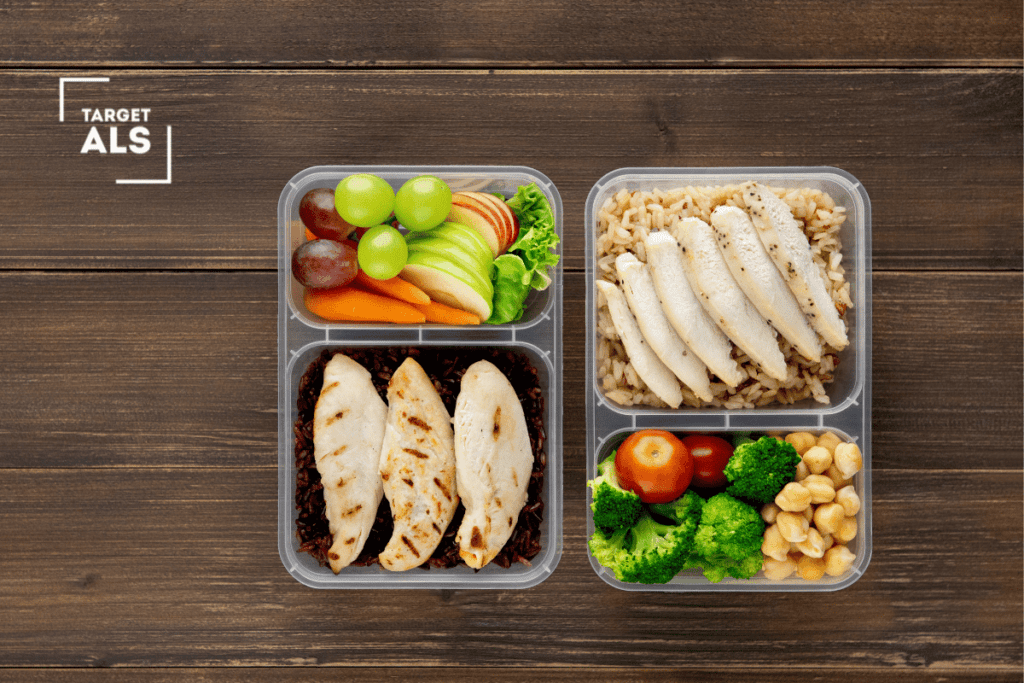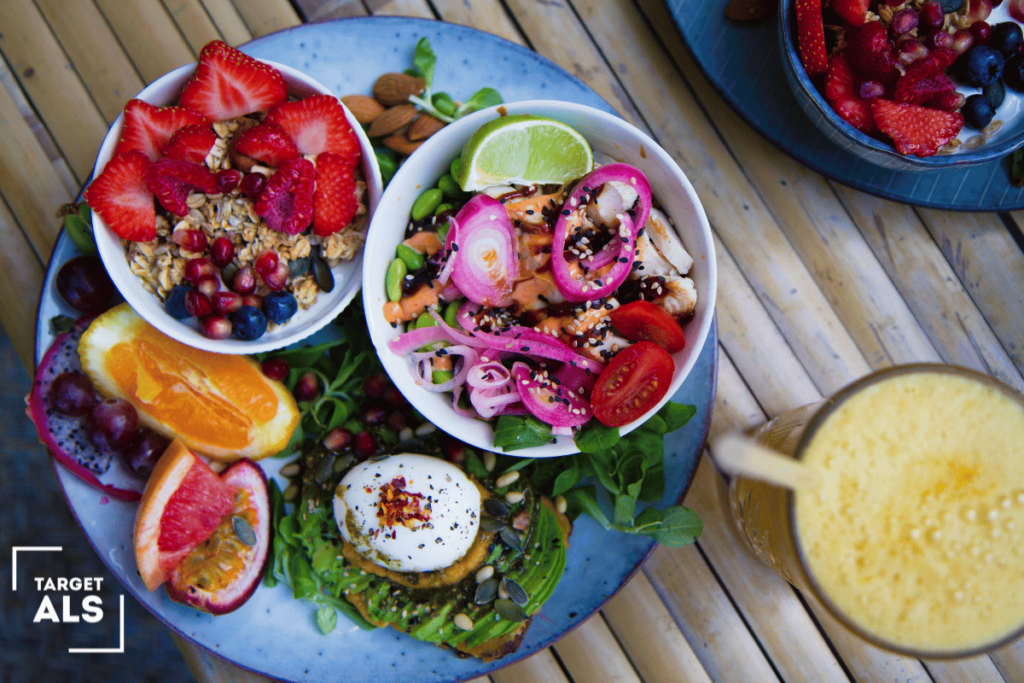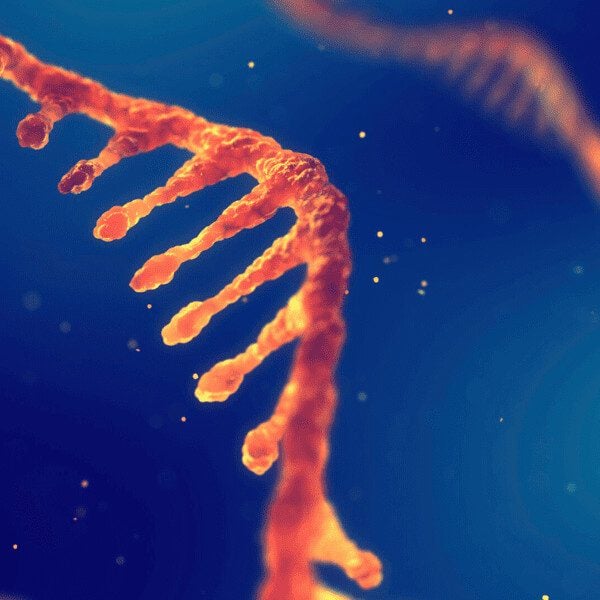According to the World Health Organization (WHO), the average person needs to regularly ingest a combination of cereals, legumes, fruits, vegetables, and foods from animal sources to thrive.1 However, even when following these recommendations and maintaining healthy eating habits, the risk of malnutrition in patients with Amyotrophic Lateral Sclerosis (ALS) is increasingly high as the condition progresses. Especially when patients are relegated to feeding tubes.

Amyotrophic Lateral Sclerosis Diet: Why Patients May Need a Special ALS Diet and Nutrition
ALS is a degenerative neuromuscular condition affecting upper and lower motor neurons, known for ultimately impairing muscle function and significantly reducing a patient’s ability to move, talk, breathe or eat without assistance.2
More than 25% of people with ALS report the following symptoms:2
- Slurred speech
- Hoarseness
- Dyspnea (shortness of breath)
- Dysphagia (difficulty swallowing)
Dysphagia causes patients to experience difficulty ingesting the necessary nutrients. The low-calorie intake caused by dysphagia may negatively affect their body weight, muscle volume, and overall health and hamper nutrition. Approximately 85% of those combating ALS will experience this symptom during the disease progression, although it typically occurs only during the late stages.3
Dysphagia is not the only ALS symptom that may have notorious adverse effects on a patient’s weight. The disease also tends to cause hypermetabolism, defined by a substantial boost in resting energy expenditure compared with predicted resting energy expenditure.4 Much like patients with trouble chewing and swallowing do, those living with ALS who present hypermetabolism may need a high-energy ALS diet to prevent malnutrition.5
Can Diet Affect ALS?
Malnutrition is a prognostic factor in ALS that is often underdiagnosed. A body mass index (BMI) lower than 18.5 kg/m2 or the loss of more than 10% of prediagnosis body weight meets the definition of malnutrition.6
Maintaining a healthy body weight and metabolism is vital to keeping the body strong and working correctly. A higher BMI proves to boost life expectancy for people with ALS.7 On the contrary, the lower the BMI, the more severe the condition could become.7 Research suggests that higher prediagnosis body fat minimized the risk of ALS-related mortality — with underweight women being more likely to die sooner from this condition.7 Fortunately, diet is adjusted to compensate for the decreasing BMI and higher energy demand in individuals with ALS.

How To Maintain Good Nutrition with ALS
When diagnosed with ALS, patients or caregivers need to monitor the deterioration of chewing and swallowing functions. As those living with the condition develop facial weakness and fatigue, they can become discouraged from eating sufficient food enough times a day to maintain their health and nutrition. In this case, caregivers can use multiple strategies to keep mealtime as comfortable as possible, including:
- Using plate guards and modified utensils to facilitate food scooping.
- Placing the plate on the same plane as the patient’s mouth.
- Adjusting the feeding set up to make it more comfortable.
- Providing smaller meals more times a day and adding snacks.
- Giving patients softer foods that require less chewing.
- Cutting food into smaller bite sizes or using a blender to make it easier to eat.
- Lubricating foods with sauces or gravy.
- Minimizing distractions during meals.
- Using a feeding tube.
Planning a Good ALS Diet
There are numerous approaches to designing an ALS diet strategy that helps prevent malnutrition in patients. The norm is increasing the calorie intake, but specialists may have different opinions regarding which macronutrients could help achieve that more effectively. While some could suggest a diet high in fat (ketogenic diet), others are more inclined to recommend a higher carbohydrate consumption.
What Foods are Good for ALS Patients?
To increase caloric intake, ALS patients can incorporate the following into their diet:8
| Fats | Carbs | Sugars |
| Butter | Bread | Jams, jellies, and marmalades |
| Olive, Canola, or Sunflower oil | Beans | Honey |
| Mayo | Pasta | Maple syrup |
| Cream Cheese | Potatoes | Fruits |
| Nuts | Cereal | |
| Peanut butter |
The energy needs of a person with ALS could be up to 15% higher than someone who doesn’t have the condition.8 Yet, it is not unusual for ALS patients to consume fewer calories per day than they need to keep that in check. It is not recommended for patients to try to lose weight once diagnosed. It is imperative to keep track of any fluctuations in their body mass.8
In addition, people with ALS must eat a balanced diet that includes foods from all major groups, including grains, fruit, vegetables, protein, dairy, and fats, to slow the process of muscle breakdown and keep their immune system strong. Consuming a proper diet will also increase the patient’s sense of well-being and improve their quality of life.8
ALS Diet and Nutrition Best Practices
It is standard for people with ALS to experience loss of appetite and experience weight loss. Still, they need to make an effort to consume the nutrients they need every day to stay as healthy as possible. Some suggestions to achieve this are:8
- Avoid long periods without food.
- Eat nutrient-dense foods.
- Drink after eating to avoid feeling full faster.
- Drink beverages that are high in calories.
- Keep enjoyable foods around.
- Make and follow a meal schedule.
- Eat with other people.
- Change the menu regularly.
In addition, patients could also drink nutritional supplements for added protein and calories to avoid weight loss. Additional supplements could be helpful to combat malnutrition in those with ALS, including vitamin E, zinc, melatonin, creatine, L-carnitine, folic acid, and vitamin B12.9
There is no official list of foods to avoid for ALS patients. Some research suggests that milk, pork, and luncheon meats could negatively affect ALS function.10 Additionally, since patients may be taking medications, alcohol intake is not recommended.
Considering a Feeding Tube
When eating becomes too much of a burden, a gastrostomy tube (feeding tube) can provide a way to get the calories, nutrients, and hydration ALS patients need.
One misconception is that once a patient agrees to a feeding tube, they can no longer eat by mouth. That’s false. This medical device can serve as a supplement to regular meals.11 When a feeding tube is in place, people with ALS can still enjoy dinner time with their family and eat tasty snacks when they feel like it.
Opting for a tube may improve your quality of life by reducing anxiety over swallowing safely and getting enough calories. People using a feeding tube often report it’s easier to get adequate calories and nutrients without concern about choking.12 In people with dysphagia, placing a feeding tube early appears to prolong survival.12

Developing an ALS Nutrition Plan
ALS patients don’t have to figure things out alone regarding their dietary needs. A registered dietitian or nutritionist will likely be part of their care team.
In addition, other professionals may be involved, including:
- Speech therapists
- Occupational therapists
- Respiratory therapists
- Gastroenterologists
Working closely with patients and caregivers, these professionals can develop strategies and care plans to ensure standards for nutrients and calories are met.13
Apps can also help. Researchers found that adding a diet-monitoring app to nutritional counseling can increase calorie intake in ALS patients. In this study, the rate of disease progression for patients using the app was half as fast as that of other patients.14
ALS Diet and Nutrition: A Final Word
Nutrition has a crucial role in supporting ALS function and increasing life expectancy. That’s why patients and caregivers need to ensure the adoption of a carefully planned ALS diet. When implemented correctly, the right dietary plan could significantly improve a patient’s quality of life.
Research is still ongoing on this subject. For instance, increasing the consumption of carotenoids, especially beta-carotene and lutein, might reduce the risk for progressive neurological diseases, including ALS. Carrots, yams, and mangoes are good sources of beta-carotene. Spinach, collard greens, and egg yolks provide lutein.15
Although still in the early stages of research, the gut microbiome likely has a role in disease development. Researchers are looking into the gut-brain connection in several neurological conditions, including ALS, Parkinson’s, and Alzheimer’s diseases.16,17
Based on what we’re seeing now, the role of nutrition in ALS will take on greater significance in the future. At Target ALS, we want ALS individuals to live as healthy as possible after their initial diagnosis. That is why we dedicate our efforts to fueling innovation in ALS treatment. Our ultimate goal is to live in a world where this condition takes fewer lives away from us. To learn more about our mission, visit targetals.org.
Frequently Asked Questions
Is weight loss common in ALS and how can it be managed through diet?
Weight loss is common in ALS due to increased energy expenditure from muscle weakness. A balanced diet with adequate caloric intake, as recommended by a healthcare professional, can help manage weight and prevent malnutrition.
Should individuals with ALS take dietary supplements?
Individuals with ALS should discuss dietary supplements with their healthcare team. While some supplements might be recommended to address specific deficiencies, it’s essential to avoid self-prescribing, as certain supplements may interfere with medications or worsen symptoms.
How can hydration be managed for those with swallowing difficulties?
Staying hydrated is vital, especially when swallowing becomes challenging. Sipping water or consuming water-rich foods can help with hydration. Consulting a speech-language pathologist can provide guidance on safe swallowing techniques and appropriate food textures.
SOURCES
1. “Healthy diet.” WHO | World Health Organization, https://www.who.int/initiatives/behealthy/healthy-diet. Accessed 10 March 2022.
2. Howard, FM. “The otolaryngologic presentation of amyotrophic lateral sclerosis.” PubMed, https://pubmed.ncbi.nlm.nih.gov/112540/. Accessed 10 March 2022.
3. “Dysphagia in Amyotrophic Lateral Sclerosis: Impact on Patient Behavior, Diet Adaptation, and Riluzole Management.” NCBI, 21 March 2017, https://www.ncbi.nlm.nih.gov/pmc/articles/PMC5359548 /. Accessed 10 March 2022.
4. Steyn, Frederik J, et al. “Hypermetabolism in ALS Is Associated with Greater Functional Decline and Shorter Survival.” Journal of Neurology, Neurosurgery & Psychiatry, BMJ Publishing Group Ltd, 1 Oct. 2018, https://jnnp.bmj.com/content/89/10/1016. Accessed 10 March 2022.
5. “High metabolic level in patients with familial amyotrophic lateral sclerosis.” PubMed, https://pubmed.ncbi.nlm.nih.gov/18792852/. Accessed 10 March 2022.
6. Piquet, MA. “[Nutritional approach for patients with amyotrophic lateral sclerosis].” PubMed, https://pubmed.ncbi.nlm.nih.gov/17128108/. Accessed 10 March 2022.
7. Pape, J.A., and J.H. Grose. “The Effects of Diet and Sex in Amyotrophic Lateral Sclerosis.” Revue Neurologique, Elsevier Masson, 5 Mar. 2020, https://www.sciencedirect.com/science/article/pii/S0035378720303970. Accessed 10 March 2022.
8. Zatavekas, Kathy. “Nutrition Considerations for People with ALS | MDA-ALS Center | University of Pittsburgh.” MDA-ALS Center, https://www.alsclinic.pitt.edu/patient-issues/nutrition-considerations-people-als. Accessed 10 March 2022.
9. “Nutrition and Dietary Supplements in Motor Neuron Disease.” NCBI, https://www.ncbi.nlm.nih.gov/pmc/articles/PMC2631353/. Accessed 10 March 2022.
10. Nieves, Jeri W. “Association Between Dietary Intake and Function in Amyotrophic Lateral Sclerosis.” NCBI, 1 December 2017, https://www.ncbi.nlm.nih.gov/pmc/articles/PMC5370581/. Accessed 10 March 2022.
11. Maintaining Adequate Nutrition: A Continuing Challenge in ALS. ALS Association
12. https://alsnewstoday.com/news-posts/2019/08/01/optimizing-diet-als-patient-nutritionists-view/”>https://alsnewstoday.com/news-posts/2019/08/01/optimizing-diet-als-patient-nutritionists-view/
13. https://www.als-mnd.org/support-for-pals-cals/clinical-care/nutrition-and-swallowing/
14. “Diet-monitoring App Can Help Slow Progression of ALS.” Mass General Advances in Motion July 9, 2019
15. https://doi.org/10.2147/DNND.S120607
16. Boddy, S.L., Giovannelli, I., Sassani, M. et al. The gut microbiome: a key player in the complexity of amyotrophic lateral sclerosis (ALS). BMC Med 19, 13 (2021). https://doi.org/10.1186/s12916-020-01885-3
17. Lau, J.: Harvard scientists identify gut-brain connection in ALS. Harvard Gazette (2020) https://news.harvard.edu/gazette/story/2020/05/harvard-scientists-identify-gut-brain-connection-in-als/




